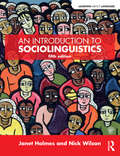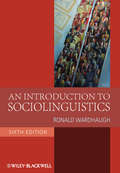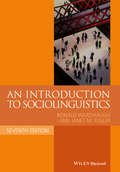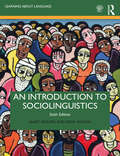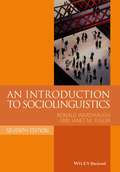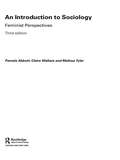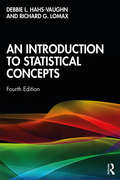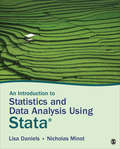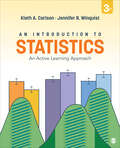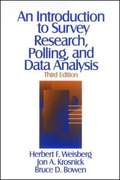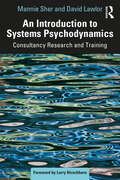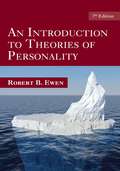- Table View
- List View
An Introduction to Sociolinguistics
by Janet Holmes Nick WilsonIn this best-selling introductory textbook, Janet Holmes and Nick Wilson examine the role of language in a variety of social contexts, considering both how language works and how it can be used to signal and interpret various aspects of social identity. Divided into three sections, this book explains basic sociolinguistic concepts in the light of classic approaches as well as introducing more recent research. This fifth edition has been revised and updated throughout using key concepts and examples to guide the reader through this fascinating area, including: a new chapter on identity that reflects the latest research; a brand new companion website which is fully cross-referenced within this book, and which includes and video and audio materials, interactive activities and links to useful websites; updated and revised examples and exercises which include new material from Tanzania, Wales, Paraguay and Timor-Leste; fully updated further reading and references sections. An Introduction to Sociolinguistics is the essential introductory text for all students of sociolinguistics and a splendid point of reference for students of English language studies, linguistics and applied linguistics.
An Introduction to Sociolinguistics
by Janet HolmesSociolinguistics is the study of the interaction between language and society. In this classic introductory work, Janet Holmes examines the role of language in a variety of social contexts, considering both how language works and how it can be used to signal and interpret various aspects of social identity. Written with Holmes' customary enthusiasm, the book is divided into three sections which explain basic sociolinguistic concepts in the light of classic approaches as well as introducing more recent research. This fourth edition has been revised and updated throughout using key concepts and examples to guide the reader through this fascinating area, including: - New sections on: koines and koineisation linguistic landscapes New Englishes Stylisation language and sexuality societal approaches to attitude research forensic linguistics - A new selection of informative examples, exercises and maps -Fully updated further reading and references sections An Introduction to Sociolinguistics is an essential introductory text for all students of sociolinguistics and a splendid point of reference for students of applied linguistics. It is also an accessible guide for those who are simply interested in language and the many and varied uses we put it to.
An Introduction to Sociolinguistics
by Ronald WardhaughThis comprehensive new edition of Wardhaugh's textbook incorporates additional study features and numerous new and updated references to bring the book completely up-to-date, whilst maintaining the features that made the book so popular with lecturers and students: accessible coverage of a wide range of issues, clearly written, and with useful student study features. A fully revised new edition of Ronald Wardhaugh's popular introduction to sociolinguistics, which now includes over 150 new and updated references and new study features throughout Features new "Explorations" sections in each chapter incorporating suggested readings, discussion sections, and exercises - all designed to encourage students to develop their own skills and ideas Reflects new developments in the field, providing greater focus on ideas such as identity, solidarity, and markedness Provides balanced coverage of a range of topics, including: language dialects, pidgins and Creoles, codes, bilingualism, speech communities, variation, words and culture, ethnographies, solidarity and politeness, talk and action, gender, disadvantage, and planning Comprehensive and accessible, it is the ideal introduction for students coming to sociolinguistics for the first time
An Introduction to Sociolinguistics (Blackwell Textbooks in Linguistics #16)
by Janet M. Fuller Ronald WardhaughThoroughly updated and revised, An Introduction to Sociolinguistics, 7th Edition presents a comprehensive and fully updated introduction to the study of the relationship between language and society. Building on Ronald Wardhaugh’s classic text, co-author Janet Fuller has updated this seventh edition throughout with new discussions exploring language and communities, language and interaction, and sociolinguistic variation, as well as incorporating numerous new exercises and research ideas for today’s students. Taking account of new research from the field, the book explores exciting new perspectives drawn from linguistic anthropology, and includes new chapters on pragmatics, discourse analysis, and sociolinguistics and education. With an emphasis on using examples from languages and cultures around the world, chapters address topics including social and regional dialects, multilingualism, discourse and pragmatics, variation, language in education, and language policy and planning. A new companion website including a wealth of additional online material, as well as a glossary and a variety of new exercises and examples, helps further illuminate the ideas presented in the text. An Introduction to Sociolinguistics, 7th Edition continues to be the most indispensable and accessible introduction to the field of sociolinguistics for students in applied and theoretical linguistics, education, and anthropology.
An Introduction to Sociolinguistics (Blackwell Textbooks in Linguistics)
by Janet M. Fuller Ronald WardhaughThe new edition of the most complete and student-friendly introduction to the field of sociolinguistics, fully revised and updated An Introduction to Sociolinguistics, Eighth Edition, is a broad overview of the study of language in social context, providing accessible coverage of major concepts, theories, methods, issues, and debates within the field. This leading textbook helps students develop a critical perspective on language in society as they explore the complex connections between societal norms and language use. Organized in four sections, the text covers traditional language issues, broad approaches to research in sociolinguistics, and language in relation to gender and sexuality, education, and policy. The eighth edition contains new and updated discussion of topics including the societal aspects of African American Vernacular English (AAVE), multilingual societies and discourse, gender and sexuality, ideologies and language attitudes, and the social meanings of linguistic forms. Fully updated throughout, this important textbook: Provides perspectives on both new and foundational research in sociolinguistics Features examples from a variety of languages and cultures that illustrate topics such as social and regional dialects, multilingualism, and language in education Includes end-of-chapter written exercises, key topic lists, chapter summaries, and “Explorations” designed to promote classroom discussion Offers students further reading suggestions, research ideas, and an updated companion website containing a searchable glossary, a review guide, additional exercises and examples, and links to online resources Includes a guide to the all explorations and exercises in the textbook, discussion topics, and other teaching resources via an instructor’s website Encouraging students to approach sociolinguistics both empirically and as a way of viewing the world around them, An Introduction to Sociolinguistics, Eighth Edition, remains the ideal textbook for upper-level undergraduate and graduate courses in sociolinguistics, language and society, anthropological linguistics, applied an
An Introduction to Sociolinguistics (Learning about Language)
by Janet Holmes Nick WilsonSociolinguistics is the study of the interaction between language and society. In this classic introductory work, Janet Holmes and Nick Wilson examine the role of language in a variety of social contexts, considering both how language works and how it can be used to signal and interpret various aspects of social identity. Divided into three parts, this book explains basic sociolinguistic concepts in the light of classic approaches, as well as introducing more recent research. This sixth edition has been revised and updated throughout, using key concepts and examples to guide the reader through this fascinating area, including: • New material on gender, social media and online use of language, code-switching, and language policy • An updated companion website that is fully cross-referenced within this book and featuring video and audio materials and links to useful websites. • Revised examples and exercises that will include new material from Asia and South America • Fully updated further reading and references sections. An Introduction to Sociolinguistics is an essential introductory text for all students of sociolinguistics and a splendid point of reference for students of English language studies, linguistics, and applied linguistics.
An Introduction to Sociolinguistics (Seventh Edition)
by Janet M. Fuller Ronald WardhaughThoroughly updated and revised, An Introduction to Sociolinguistics, 7th Edition presents a comprehensive and fully updated introduction to the study of the relationship between language and society. <p><p> Building on Ronald Wardhaugh’s classic text, co-author Janet Fuller has updated this seventh edition throughout with new discussions exploring language and communities, language and interaction, and sociolinguistic variation, as well as incorporating numerous new exercises and research ideas for today’s students. Taking account of new research from the field, the book explores exciting new perspectives drawn from linguistic anthropology, and includes new chapters on pragmatics, discourse analysis, and sociolinguistics and education. With an emphasis on using examples from languages and cultures around the world, chapters address topics including social and regional dialects, multilingualism, discourse and pragmatics, variation, language in education, and language policy and planning.
An Introduction to Sociology
by Karim Murji John Solomos Sarah NealAn Introduction to Sociology is your essential guide to understanding the social forces that shape our lives and the world around us. This innovative textbook introduces you to the key theories, themes, and concepts in the discipline of sociology and helps you to develop as a sociologist by providing comprehensive coverage of all the main areas of study. Presenting you with the history, current debates and recent research developments for each topic, this book covers everything from classical sociologies and traditional subjects such as class, families, and religion, through to more progressive areas like digital society, social media, migration, and the interconnectedness of modern global society. The book's extensive coverage means it can be used throughout your studies, from first year to final year. Key features: Each chapter is written by an internationally renowned expert who uses specialist insight and the latest research to provide a reliable and up-to-date overview. Includes a selection of unique learning features such as “Hear from the Expert” boxes and “Key Cases” from around the world, as well as reflective activities and revision questions that will enhance your knowledge. Features a section titled “What is sociology useful for?” which includes chapters on the public value of sociology and the role of sociology in contemporary society. The book is supported by a wide-ranging collection of online teaching and learning resources including exclusive video content from SAGE Video, links to SAGE Journal Articles, sample essay questions, and a selection of multiple-choice questions. This definitive text is perfect for first-year sociology undergraduates and anyone studying sociology at university or college level.
An Introduction to Sociology
by Karim Murji John Solomos Sarah NealAn Introduction to Sociology is your essential guide to understanding the social forces that shape our lives and the world around us. This innovative textbook introduces you to the key theories, themes, and concepts in the discipline of sociology and helps you to develop as a sociologist by providing comprehensive coverage of all the main areas of study. Presenting you with the history, current debates and recent research developments for each topic, this book covers everything from classical sociologies and traditional subjects such as class, families, and religion, through to more progressive areas like digital society, social media, migration, and the interconnectedness of modern global society. The book′s extensive coverage means it can be used throughout your studies, from first year to final year. Key features: Each chapter is written by an internationally renowned expert who uses specialist insight and the latest research to provide a reliable and up-to-date overview. Includes a selection of unique learning features such as “Hear from the Expert” boxes and “Key Cases” from around the world, as well as reflective activities and revision questions that will enhance your knowledge. Features a section titled “What is sociology useful for?” which includes chapters on the public value of sociology and the role of sociology in contemporary society. The book is supported by a wide-ranging collection of online teaching and learning resources including exclusive video content from SAGE Video, links to SAGE Journal Articles, sample essay questions, and a selection of multiple-choice questions. This definitive text is perfect for first-year sociology undergraduates and anyone studying sociology at university or college level.
An Introduction to Sociology
by Karim Murji John Solomos Sarah NealAn Introduction to Sociology is your essential guide to understanding the social forces that shape our lives and the world around us. This innovative textbook introduces you to the key theories, themes, and concepts in the discipline of sociology and helps you to develop as a sociologist by providing comprehensive coverage of all the main areas of study. Presenting you with the history, current debates and recent research developments for each topic, this book covers everything from classical sociologies and traditional subjects such as class, families, and religion, through to more progressive areas like digital society, social media, migration, and the interconnectedness of modern global society. The book′s extensive coverage means it can be used throughout your studies, from first year to final year. Key features: Each chapter is written by an internationally renowned expert who uses specialist insight and the latest research to provide a reliable and up-to-date overview. Includes a selection of unique learning features such as “Hear from the Expert” boxes and “Key Cases” from around the world, as well as reflective activities and revision questions that will enhance your knowledge. Features a section titled “What is sociology useful for?” which includes chapters on the public value of sociology and the role of sociology in contemporary society. The book is supported by a wide-ranging collection of online teaching and learning resources including exclusive video content from SAGE Video, links to SAGE Journal Articles, sample essay questions, and a selection of multiple-choice questions. This definitive text is perfect for first-year sociology undergraduates and anyone studying sociology at university or college level.
An Introduction to Sociology
by Ken BrowneThis fifth edition of An Introduction to Sociology provides an accessible and engaging introduction to sociology, without oversimplifying or passing over the important and exciting insights sociology has to offer. Building on the book's existing achievements, Ken Browne has restructured the fifth edition to focus on the core issues in sociology considered in introductory courses. The book covers all the topics and options specified by the GCSE and IGCSE examining boards, including the required classic texts and theoretical perspectives which are helpfully applied throughout the chapters. The new edition has been completely updated to reflect contemporary social changes, including the latest statistics and topical illustrative examples. New material is to be found throughout, such as more extensive treatment of family and household diversity, the marketization of education, social inequality, the control and prevention of crime, and the effects of new media technologies. Carefully designed to support and extend students' learning, a number of features – such as a range of activities, questions and discussion points – add to the book's value as a learning and teaching resource. Explanatory graphics, photographs and cartoons also enliven the text, presenting sociology as an exciting and relevant topic to students of all ages, interests and abilities. The new edition of this highly successful textbook will prove invaluable to anyone first approaching sociology, especially on Access, GCSE and related courses. Students will find the book provides an easy-to-follow and thoughtful introduction to studying sociology.
An Introduction to Sociology: Feminist Perspectives
by Pamela Abbott Claire Wallace Melissa TylerThis third edition of this best-selling book confirms the ongoing centrality of feminist perspectives and research to the sociological enterprise, and introduces students to the wide range of feminist contributions in key areas of sociological concern. Completely revised, this edition includes: new chapters on sexuality and the media additional material on race and ethnicity, disability and the body many new international and comparative examples the influence of theories of globalization and post-colonial studies. In addition, the theoretical elements have also been fully rethought in light of recent developments in social theory. Written by three experienced teachers and examiners, this book gives students of sociology and women's studies an accessible overview of the feminist contribution to all the key areas of sociological concern.
An Introduction to Sociology: Feminist Perspectives
by Pamela Abbott Claire Wallace Melissa TylerThis third edition of this best-selling book confirms the ongoing centrality of feminist perspectives and research to the sociological enterprise, and introduces students to the wide range of feminist contributions in key areas of sociological concern. Completely revised, this edition includes: new chapters on sexuality and the media additional material on race and ethnicity, disability and the body many new international and comparative examples the influence of theories of globalization and post-colonial studies. In addition, the theoretical elements have also been fully rethought in light of recent developments in social theory. Written by three experienced teachers and examiners, this book gives students of sociology and women's studies an accessible overview of the feminist contribution to all the key areas of sociological concern.
An Introduction to Spatial Planning in the Netherlands
by Thomas Hartmann Patrick WitteThis book provides an introduction to spatial planning in the Netherlands. It explores the academic underpinnings of the discipline and its practical implications, making use of insights on planning practices from the Netherlands. As an academic book with relevance for spatial planning teaching and practice, the relation between planning practice and planning as an academic discipline are discussed. A key analytical concept is introduced to discuss the different dimensions of planning: the planning triangle. This framework helps to bridging the strategic and conceptual elements of planning with its realization. The object, process and context of planning and its relations are discussed. The core of the academic discipline and profession of spatial planning entails looking (far) into the future, stimulating discussion, formulating a desired future direction through an informal and collective planning process and then formalizing and placing current action into that future perspective. In that sense, spatial planning can be understood as the strategic organisation of hopes and expectations. As a study book it is suitable for students of planning at various universities, but also for students in higher professional education. For those involved in the professional field of spatial planning, this book offers a sound foundation.
An Introduction to Statistical Concepts: Third Edition
by Debbie L. Hahs-Vaughn Richard G. LomaxThis comprehensive, flexible text is used in both one- and two-semester courses to review introductory through intermediate statistics. Instructors select the topics that are most appropriate for their course. Its conceptual approach helps students more easily understand the concepts and interpret SPSS and research results. Key concepts are simply stated and occasionally reintroduced and related to one another for reinforcement. Numerous examples demonstrate their relevance. This edition features more explanation to increase understanding of the concepts. Only crucial equations are included.In addition to updating throughout, the new edition features: New co-author, Debbie L. Hahs-Vaughn, the 2007 recipient of the University of Central Florida's College of Education Excellence in Graduate Teaching Award. A new chapter on logistic regression models for today's more complex methodologies. More on computing confidence intervals and conducting power analyses using G*Power. Many more SPSS screenshots to assist with understanding how to navigate SPSS and annotated SPSS output to assist in the interpretation of results. Extended sections on how to write-up statistical results in APA format. New learning tools including chapter-opening vignettes, outlines, and a list of key concepts, many more examples, tables, and figures, boxes, and chapter summaries. More tables of assumptions and the effects of their violation including how to test them in SPSS. 33% new conceptual, computational, and all new interpretative problems. A website that features PowerPoint slides, answers to the even-numbered problems, and test items for instructors, and for students the chapter outlines, key concepts, and datasets that can be used in SPSS and other packages, and more. Each chapter begins with an outline, a list of key concepts, and a vignette related to those concepts. Realistic examples from education and the behavioral sciences illustrate those concepts. Each example examines the procedures and assumptions and provides instructions for how to run SPSS, including annotated output, and tips to develop an APA style write-up. Useful tables of assumptions and the effects of their violation are included, along with how to test assumptions in SPSS. 'Stop and Think' boxes provide helpful tips for better understanding the concepts. Each chapter includes computational, conceptual, and interpretive problems. The data sets used in the examples and problems are provided on the web. Answers to the odd-numbered problems are given in the book. The first five chapters review descriptive statistics including ways of representing data graphically, statistical measures, the normal distribution, and probability and sampling. The remainder of the text covers inferential statistics involving means, proportions, variances, and correlations, basic and advanced analysis of variance and regression models. Topics not dealt with in other texts such as robust methods, multiple comparison and nonparametric procedures, and advanced ANOVA and multiple and logistic regression models are also reviewed.Intended for one- or two-semester courses in statistics taught in education and/or the behavioral sciences at the graduate and/or advanced undergraduate level, knowledge of statistics is not a prerequisite. A rudimentary knowledge of algebra is required.
An Introduction to Statistical Concepts: Third Edition
by Richard G. Lomax Debbie L. Hahs-VaughnThe new edition of An Introduction to Statistical Concepts, is designed to help students really understand statistical concepts, the situations in which they can be used, and how to apply them to data. Hahs-Vaughn and Lomax discuss the most popular, along with many of the lesser-known, procedures and models, whilst also exploring nonparametric procedures used when standard assumptions are violated. They provide in-depth coverage of testing assumptions and highlight several online tools for computing statistics (e.g., effect sizes and their confidence intervals and power). This comprehensive, flexible and accessible text includes a new chapter on mediation and moderation; expanded coverage of effect sizes; discussions of sensitivity, specificity, false positive, and false negative, along with using the receiver operator characteristic (ROC) curve. This book, noted for its crystal-clear explanations, and its inclusion of only the most crucial equations, is an invaluable resource for students undertaking a course in statistics in any number of social science and behavioral disciplines—from education, business, communication, exercise science, psychology, sociology and more.
An Introduction to Statistics and Data Analysis Using Stata®: From Research Design to Final Report
by Lisa Daniels Nicholas W. MinotAn Introduction to Statistics and Data Analysis Using Stata® by Lisa Daniels and Nicholas Minot provides a step-by-step introduction for statistics, data analysis, or research methods classes with Stata. Concise descriptions emphasize the concepts behind statistics for students rather than the derivations of the formulas. With real-world examples from a variety of disciplines and extensive detail on the commands in Stata, this text provides an integrated approach to research design, statistical analysis, and report writing for social science students.
An Introduction to Statistics and Data Analysis Using Stata®: From Research Design to Final Report
by Lisa Daniels Nicholas W. MinotAn Introduction to Statistics and Data Analysis Using Stata® by Lisa Daniels and Nicholas Minot provides a step-by-step introduction for statistics, data analysis, or research methods classes with Stata. Concise descriptions emphasize the concepts behind statistics for students rather than the derivations of the formulas. With real-world examples from a variety of disciplines and extensive detail on the commands in Stata, this text provides an integrated approach to research design, statistical analysis, and report writing for social science students.
An Introduction to Statistics and Data Analysis Using Stata®: From Research Design to Final Report
by Lisa Daniels Nicholas W. MinotAn Introduction to Statistics and Data Analysis Using Stata®: From Research Design to Final Report, Second Edition provides an integrated approach to research methods, statistics and data analysis, and interpretation of results in Stata. Drawing on their combined 25 years of experience teaching statistics and research methods, authors Lisa Daniels and Nicholas Minot frame data analysis within the research process—identifying gaps in the literature, examining the theory, developing research questions, designing a questionnaire or using secondary data, analyzing the data, and writing a research paper—so readers better understand the context of data analysis. Throughout, the text focuses on documenting and communicating results so students can produce a finished report or article by the end of their courses. The Second Edition has been thoroughly updated with all new articles and data—including coverage of ChatGPT, COVID-19 policies, and SAT scores—to demonstrate the relevance of data analysis for students. A new chapter on advanced methods in regression analysis allows instructors to better feature these important techniques. Stata code has been updated to the latest version, and new exercises throughout offer more chances for practice.
An Introduction to Statistics and Data Analysis Using Stata®: From Research Design to Final Report
by Lisa Daniels Nicholas W. MinotAn Introduction to Statistics and Data Analysis Using Stata®: From Research Design to Final Report, Second Edition provides an integrated approach to research methods, statistics and data analysis, and interpretation of results in Stata. Drawing on their combined 25 years of experience teaching statistics and research methods, authors Lisa Daniels and Nicholas Minot frame data analysis within the research process—identifying gaps in the literature, examining the theory, developing research questions, designing a questionnaire or using secondary data, analyzing the data, and writing a research paper—so readers better understand the context of data analysis. Throughout, the text focuses on documenting and communicating results so students can produce a finished report or article by the end of their courses. The Second Edition has been thoroughly updated with all new articles and data—including coverage of ChatGPT, COVID-19 policies, and SAT scores—to demonstrate the relevance of data analysis for students. A new chapter on advanced methods in regression analysis allows instructors to better feature these important techniques. Stata code has been updated to the latest version, and new exercises throughout offer more chances for practice.
An Introduction to Statistics: An Active Learning Approach
by Jennifer R. Winquist Kieth Alton CarlsonThis updated and reorganized Third Edition of this textbook takes a workbook-style approach that encourages an active approach to learning statistics. Carefully placed reading questions throughout each chapter allow students to apply their knowledge right away, while in-depth activities based on current behavioral science scenarios, each with problem sets and quiz questions, give students the opportunity to assess their understanding of concepts while reading detailed explanations of more complex statistical concepts. Additional practice problems further solidify student learning. Most activities are self-correcting, so if a concept is misunderstood, this misunderstanding is corrected early in the learning process. After working through each chapter, students are far more likely to understand the material than when they only read the material.
An Introduction to Statistics: An Active Learning Approach
by Jennifer R. Winquist Kieth Alton CarlsonThis updated and reorganized Third Edition of this textbook takes a workbook-style approach that encourages an active approach to learning statistics. Carefully placed reading questions throughout each chapter allow students to apply their knowledge right away, while in-depth activities based on current behavioral science scenarios, each with problem sets and quiz questions, give students the opportunity to assess their understanding of concepts while reading detailed explanations of more complex statistical concepts. Additional practice problems further solidify student learning. Most activities are self-correcting, so if a concept is misunderstood, this misunderstanding is corrected early in the learning process. After working through each chapter, students are far more likely to understand the material than when they only read the material.
An Introduction to Survey Research, Polling, and Data Analysis (3rd edition)
by Herbert F. Weisberg Jon A. Krosnick Bruce D. BowenExplains how surveys are conducted, how to read statistical reports, and how to analyze data, and provides guidelines for evaluating polls. Coverage includes understanding tables, interval statistics, survey design, sampling and question-writing, interviewing and coding strategies, analysis of different types of surveys, and reading and writing reports. Includes chapter exercises and answers. Paper edition (unseen), $25. 95. Annotation c. by Book News, Inc. , Portland, Or.
An Introduction to Systems Psychodynamics: Consultancy Research and Training
by Mannie Sher David LawlorThis book provides an introduction to systems psychodynamic theory and its application to organisational consultancy, research and training, outlining systems dynamics methods and their historical and theoretical developments. Systems Psychodynamics is an emerging field of social science, the boundaries of which are continually being refined and re-defined. The ‘systems’ designation refers to open systems concepts that provide the framing perspective for understanding the structural aspects of organisational systems. These include its design, division of labour, levels of authority, and reporting relationships; the nature of work tasks, processes, and activities; its mission and primary task; and the nature and patterning of the organisation’s task and sentient boundaries and the transactions across them. This book presents a critical appraisal of the systems psychodynamics paradigm and its application to present-day social and organisational difficulties, showing how a holistic approach to organisational and social problems can offer a fresh perspective on difficult issues. Bringing together the theory and practice of systems psychodynamics for the first time, this book provides an examination of the systems psychodynamics paradigm in action. This book gives an accessible and thorough guide to understanding and using systems psychodynamic ideas for analysts, managers, policy makers, consultants and researchers in a wide range of professional and clinical settings.
An Introduction to Theories of Personality: 7th Edition
by Robert B. Ewen Robert Ewen BThis 7th Edition helps students unravel the mysteries of human behavior through its highly readable introduction to the ideas of the most significant personality theorists. Engaging biographical sketches begin each chapter, and unique capsule summaries help students review key concepts. Theories come alive through the inclusion of quotations from the theorists’ writings and numerous applications such as dream interpretation, psychopathology, and psychotherapy. Significant changes in the 7th edition include an extended discussion of the practical applications of personality theory, with an emphasis on guidelines that can help people increase their self-knowledge, make better decisions, and live more fulfilling lives. Fictionalized but true-to-life examples illustrating the perils of inadequate self-knowledge include college students, parents, terrorists, business executives, and politicians, while other examples show the positive outcomes that can result from a better understanding of one’s unconscious. This 7th edition also includes a more extensive discussion of how a lack of self-understanding caused difficulties for such noted theorists as Freud and Erikson, and a new section that explains how behavior can be strongly influenced by the situation as well as by one’s personality. Finally, a new interactive web site provides practice test questions and other topics of interest.
